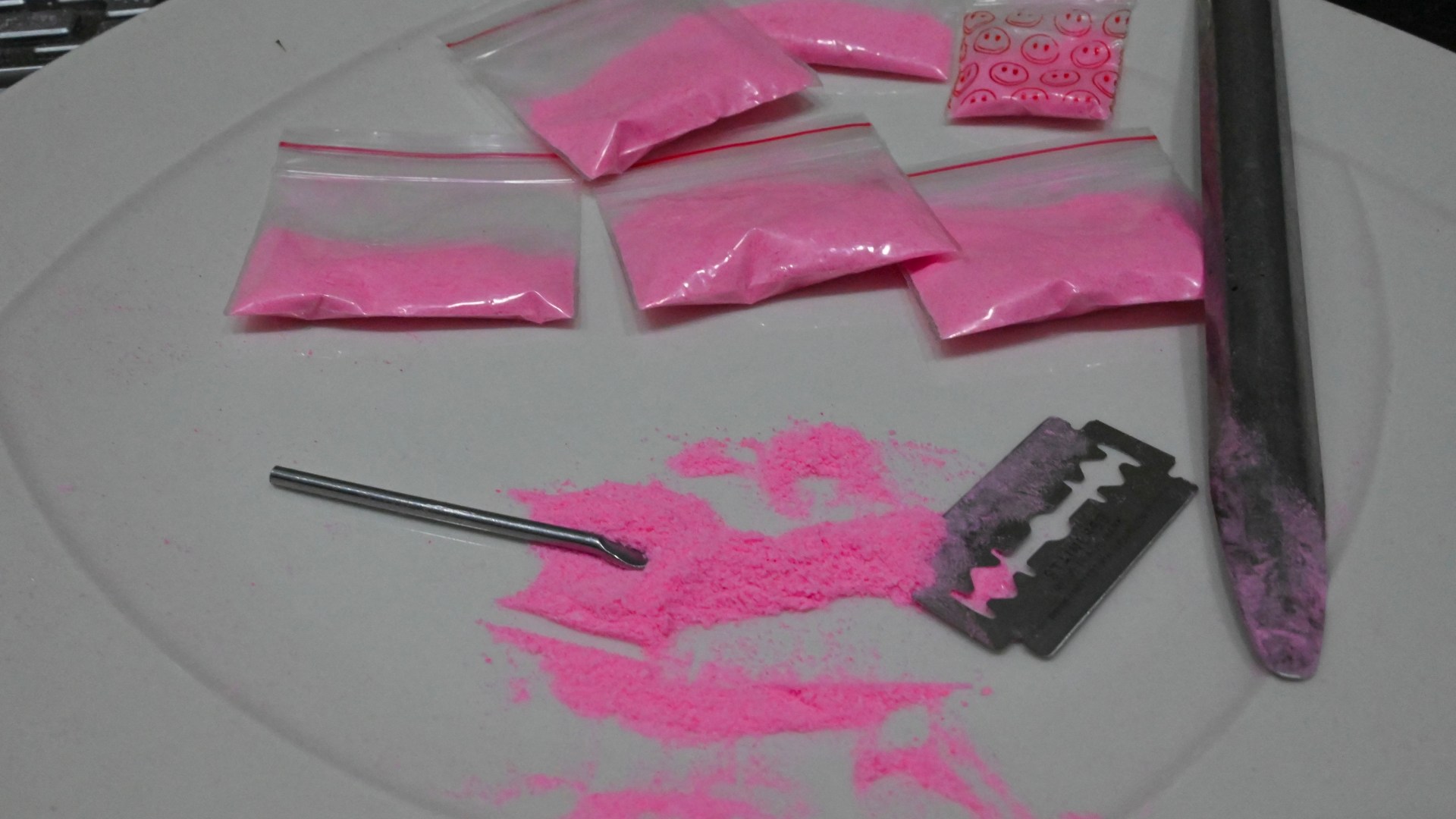A DANGEROUS ‘Russian roulette’ drug cocktail dubbed ‘pink cocaine’ has been linked to a surge in drug deaths, experts have warned.
Hot pink and strawberry-scented, the concoction also known as ‘tusi’, ‘cocaina rosada’, ‘Venus’ and ‘Eros’ has seen a rapid surge in popularity.
7

7

7

7
But, it turns out its name is misleading – ‘pink cocaine’ doesn’t necessarily contain much of the stimulant at all.
Instead, it’s often a mish-mash of MDMA, ketamine and food dye that first burst onto the Latin American party scene before spreading into European holiday hotspots and the UK.
Packets of the drug have since been reported by authorities in England, Scotland and Wales, as well as the US, while its distribution has been linked to the Mexican Sinaloa Cartel – run by the sons of former cartel boss El Chapo.
Experts have compared taking the drug to playing Russian Roulette, as its unpredictable mix of substances can heighten the risk of experiencing dangerous reactions.
Public Health Scotland issued a warning over pink cocaine and MDMA tablets in January this year after three teenagers died in less than six months after attending events held at a Glasgow music venue.
And yesterday “alarming” new figures from the Office of National Statistics (ONS) showed that the total number of drug-related deaths in England and Wales reached a new record high last year.
Cocaine use accounted for a large number of these, soaring by 30 per cent in a year making up a fifth of all drug-poisoning deaths.
But what is pink cocaine, what does it contain, what makes it so dangerous, where it’s coming from and how can we reduce its risk of harm?
What’s actually in pink cocaine?
Despite the name, this so-called ‘designer drug’ doesn’t necessarily contain cocaine.
Instead, the synthetic drug cocktail tends to be a mixture of various other substances, including MDMA, ketamine and 2C-B.
Dr Joseph Janes, a lecturer in criminology at Swansea University explained the various effect each component can have.
Writing for The Conversation, he said: “MDMA, commonly known as ecstasy, is a stimulant with psychedelic properties while ketamine is a powerful anaesthetic which has sedative and hallucinogenic effects.
Today’s pink cocaine is an unpredictable mix of substances and that is where much of its danger lies
Dr Joseph Janes
“2C drugs are classed as psychedelics but they can also produce stimulant effects.”
As a result, the pink-tinged mixture also has hallucinogenic properties, unlike the purely stimulant effects of traditional cocaine.
England and Wales see record drug deaths

The total number of drug-related deaths registered in England and Wales reached a new record high last year, according to the Office for National Statistics (ONS).
In particular, deaths involving cocaine soared by 30 per cent.
There were 1,118 deaths involving cocaine registered in 2023, making up a fifth of all drug-poisoning deaths.
This was 30.5 per cent higher than the previous year when there were 857 deaths, and almost 10 times higher than in 2011 when 112 deaths were registered.
In the past decade, cocaine has consistently been the second most-used drug, after cannabis, in England and Wales, the ONS said.
Robin Pollard, head of policy at WithYou, said: “Across almost all areas where WithYou delivers services, we hear that cocaine has become far more prevalent.
“It has also become easier to purchase in all parts of the country, has become increasingly socially acceptable, and of higher purity.
“We also know that cocaine use tends to be associated more with men, but they can be more hesitant to access support for their drug use.”
Across the two nations, 5,448 deaths related to drug poisoning were registered in 2023, which the ONS said is the highest since records began in 1993.
Almost half of deaths (46.8 per cent) involved an opiate such as heroin or morphine, amounting to 2,551 drug-poisoning deaths.
This was 12.8% higher than the previous year, the ONS said.
Simon Phillips, Chief Executive of WithYou, said: “Every single one of these deaths is a preventable, avoidable tragedy.
“Behind the numbers are real people, with family and friends grieving their loss. My thoughts are with them today.
“Steps to increase the supply and accessibility of naloxone must be implemented as soon as possible, and we want the Government to go even further, and ensure it is available to all opiate users and their friends and family members too.
“In our services, we’re hearing more about dangerous contaminated drugs; widespread drug-checking services need to be accessible so people know what they’re taking.
“Drug consumption rooms are also needed, where people who use drugs can do so safely – reducing overdose risk and needle-sharing, and improving access to treatment.
“The Government must also commit to tackling the root causes of why people have challenges with drugs.
“We cannot stop drug-related deaths if people don’t have safe places to live, access to health and mental health services, and a safety net for when they need it.”
If you’re worried about your drug use, or that of someone close to you, you can use WithYou’s webchat, available at wearewithyou.org.uk, for free, confidential advice from expert recovery workers.
“Users of pink cocaine report both euphoric and psychedelic experiences, including altered sensory perception and mood swings,” UK Addiction Treatment Centres said.
Studies have found batches of the drug containing methamphetamine, MDMA, bath salts, caffeine and opioids, Joseph Palamar, who studies drug trends at NYU Langone Health in New York, said.
As for their signature vibrant rose hue, pink cocaine powder and pills are usually dyed using food colouring.
Strawberry or other flavourings are also often added.

7
When was it first ‘invented’?
According to Dr Janes the original psychedelic form of the drug dates to 1974 and was first synthesised by American biochemist, Alexander Shulgin.
“But the modern variant emerged around 2010 in Colombia and is a knock-off version,” he explained.
Users often expect a stimulant similar to cocaine, but the inclusion of ketamine can lead to serious health risks
Dr Joseph Janes
“The drug gained popularity on the party scene in Latin America and has now spread to Europe.”
According to UK Addiction Treatment Centres, the drug’s popularity surged during the COVID-19 pandemic, as lockdowns and social isolation drove increased drug use.
What makes pink cocaine so dangerous?
“Today’s pink cocaine is an unpredictable mix of substances and that is where much of its danger lies,” Dr Janes warned.
It’s impossible to know what’s mixed into each batch of the drug, so it’s hard to predict what kind of reaction someone might have.
“Users often expect a stimulant similar to cocaine, but the inclusion of ketamine can lead to serious health risks,” Dr Janes explained.
“Abuse of ketamine, which is widely available as a club drug, can lead to unconsciousness or dangerously laboured breathing.
“This in turn increases the potential dangers of pink cocaine.”
Dr Palamar noted that if you’ve been drinking, adding pink cocaine into the mix is going to make you sick to your stomach and the dissociative effects are not going to be very pleasant.
While its pink hue and “designer” label may attract a younger crowd, the unpredictable cocktail of chemicals it contains presents a serious and growing danger
Dr Joseph Janes
Following the explosion of the drug onto the Ibiza party scene, health experts warned: “Taking pink cocaine is like playing Russian roulette. You never know what you’re going to get.”
UK Addiction Treatment Centres added: “The variability in its composition makes each batch potentially dangerous, with the possibility of severe health effects including addiction, overdose, and fatal interactions.”
There’s additional cause for alarm among health officials across Europe, as pink cocaine is difficult to detect through standard drug testing.
The drug has been linked to several deaths over the years, such as that of Camila Sterling, a 24-year-old aspiring singer found dead in a Miami hotel room last year.
Instagram model Maecee Marie Lathers was also arrested after killing two people in a crash while allegedly under the influence of pink cocaine.
Where is pink cocaine coming from?
In May, the US Coast Guard reported seizing pink cocaine among other drugs off the coasts of Mexico and Central and South America.
Dr Palamar said: “That was the first time that I heard of large batches being imported into the US as tusi.”

7

7
Pink cocaine distribution varies but US authorities claim some of the supply entering their country is being driven by the Mexican Sinaloa Cartel, led by the sons of the infamous Mexican drug lord El Chapo,
A report from the US Drug Enforcement Agency (DEA) flagged pink cocaine as a rising concern and noted the Sinaloa Cartel was taking advantage of growing interest in the drug.
How to minimise harm from pink cocaine
Dr Janes said drug-checking kits are an important harm-reduction tool for people looking to test the substances they intend to consume.
These kits can help users identify unknown components, offering a layer of protection in a high-risk environment.
“The growing popularity of pink cocaine is a stark reminder of the ever-changing landscape of illicit drugs, where aesthetics, social media trends and risky behaviour can combine to create new threats,” he said.
“While its pink hue and “designer” label may attract a younger crowd, the unpredictable cocktail of chemicals it contains presents a serious and growing danger.”
Signs your loved one is struggling with drug addiction

Spotting signs of drug addiction in a loved one isn’t easy.
It can manifest itself differently in people and some can be good at hiding it.
Here are some of the signs to look for in your loved ones:
- Changes in mood or behaviour
- Changes in appearance
- Neglecting responsibilities
- Financial problems
- Relationship difficulties
- Secretive or suspicious behaviour
Drugs and alcohol can be hard subjects to discuss, especially if you think your friend or relative has a problem.
Try to stay open-minded and remember that, with the right help and support, most people overcome their use before any serious harm is caused. Also, even if you do offer support, they might not change their behaviour.
You or your friend can call FRANK anytime on 0300 123 6600 for confidential advice.
Sources: UKAT, Frank




